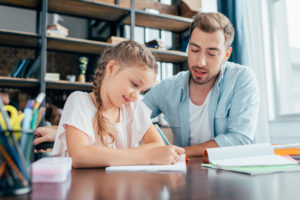Helping Your Child Get Organized From the Inside Out

Our environment has a significant impact on how we function in the world. For those with attention issues, visual clutter can be plain overwhelming. Many of us enjoy a serious purge or de-clutter, and some look to professional organizers, feng shui specialists, or life coaches to help out. These approaches can be helpful, and I recommend them for families.
Internal organization is as equally important as the external organization of our environment. We all use strategies every day in an attempt to help ourselves become internally organized, or, to stay focused. For example,
Things that stimulate the sense of touch (tactile sense):
-
- Fidgeting with a pen or small toy, holding a blankie or “lovey,” twirling hair, or touching others
- Stimulating the mouth, such as chewing on pen tops, clothing, biting fingers or fingernails, and chewing gum
Things that stimulate taste and smell (gustatory and olfactory senses):
-
- Eating very bland or very spicy foods
- Enjoying scents such as cinammon and lavender
Considerations for the sense of hearing (auditory sense):
-
- Listening to music
- A quiet environment
Things that stimulate the sense of movement and position (vestibular and proprioceptive senses):
-
- Constant fidgeting or wiggling in seats in school and during meals
- High need for physical activity during the day
- “Rough and tumble” enjoyment of banging and crashing into things (or people) on purpose
- Sleeping under heavy covers, or burrowing under a mountain of pillows
When we start to look at organization in this way, we begin to see how a child can seek organization in the context of his/her environment.
For children (or adults) who have ADD, ADHD, or sensory processing issues, certain activities throughout the day are helpful to keep organized and focused. Generally speaking, “heavy work” (activities that provide proprioception, or, stimulation to the joints and muscles of the body), such as lifting, pushing, pulling, running, climbing, or jumping, have an organizing effect on the central nervous system. For some children, providing a high level of movement during the day is important (biking, swings on the playground, supervised use of a mini-trampoline). Other children enjoy the use of gum, chewy tubes, fidget toys, or “loveys” to stay focused and calm. Each child is different, and what works for each is unique.
Here are some general tips for organization you can try:
-
- Create a visually calm environment in your home, especially around the family table and homework space. De-clutter and get organized. Use floor lamps or dimmers if necessary. This will help to decrease visual distraction.
- Too much noise? Turn off the TV, radio, and lower your voice.
- Make a family walk or bike ride a habit at night. Getting fresh air and exercise after dinner versus using video games or TV before bed will help to get the body ready to sleep and help to organize the nervous system.
- Pay attention to your child's habits: does s/he chew on things? Try gum, a chewy tube, or even a cinnamon stick (for older children) instead of letting them chew on fingers, or clothing.
- Encourage your child to get a burst of physical activity before sitting down for homework. This can help to improve concentration and focus.
If your child is having trouble managing behaviors at home, in school, or in the community that are regularly interfering with his or her functional performance (i.e. can't sit still, aggression with peers, constant need to bite or chew objects), you may also consider seeking out an occupational therapist who is trained in sensory integration. There are various assessment tools and questionnaires that can help the therapist discover your child's preferences and/or areas of struggle. The use of a specialized therapy plan and a home program (sometimes referred to as a “sensory diet”) can help your child process sensory information more efficiently, and also to help him or her learn about ways to get more organized.

